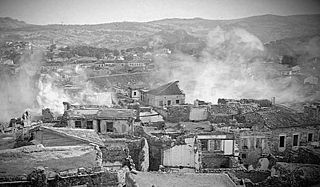
Back مذبحة فوكايا Arabic Σφαγή της Φώκαιας Greek Pembantaian Fokaia ID Massacre de Phocaea Portuguese Резня в Фокее Russian Масакр у Фокеји Serbian Foça Katliamı Turkish
| Massacre of Phocaea | |
|---|---|
| Part of the Greek genocide | |
 Old Phocaea in flames, during the massacre perpetrated by Turkish irregulars | |
| Location | Phocaea/Eskifoça and Yeni Foça, Ottoman Empire |
| Date | 12–18 June 1914 |
| Target | Greek population |
| Deaths | c. 50,[1] 100[2] or 200 killed,[3] c. 6,200 fled (entire town)[4][5] The county population decreased from 23,000 to 4,000[6] |
| Perpetrators | Turkish irregulars (Bashi-bazouk, Cretan Turks) Ottoman army[6] Ottoman police ordered by the Young Turk government |
The massacre of Phocaea (Greek: Η Σφαγή της Φώκαιας, I Sfagí tis Fókaias; Turkish: Foça Katliamı) occurred in June 1914, as part of the ethnic cleansing policies of the Ottoman Empire that included exile, massacre and deportations.[7] It was perpetrated by irregular Turkish bands against the predominantly ethnic Greek[8] town of Phocaea, modern Foça, in the east coast of the Aegean Sea.[9] The massacre was part of a wider anti-Greek campaign of genocide launched by the Young Turk Ottoman authorities, which included boycott, intimidation, forced deportations and mass killings;[10] and was one of the worst attacks during the summer of 1914.[7]
- ^ Akçam, Taner (2012). The Young Turks' Crime Against Humanity: The Armenian Genocide and Ethnic Cleansing in the Ottoman Empire. Princeton/Oxford: Princeton University Press. p. 84.
- ^ Cite error: The named reference
NYTarchiveswas invoked but never defined (see the help page). - ^ Eibner, John (2017). The Future of Religious Minorities in the Middle East. Lexington Books. p. 6. ISBN 978-1-4985-6197-6.
- ^ Bjornlund, 2013: p. 47
- ^ Cite error: The named reference
Smith32was invoked but never defined (see the help page). - ^ a b Cite error: The named reference
Emre Erolwas invoked but never defined (see the help page). - ^ a b Bjornlund, 2013: p. 40
- ^ Cite error: The named reference
Smith31was invoked but never defined (see the help page). - ^ Αγτζίδης, Β. (15 June 2014). "Η καταστροφή της Φώκαιας στην Ιωνία" (in Greek). Archived from the original on 1 July 2017. Retrieved 26 June 2017.
- ^ Lieberman, 2013: pp. 79–80
© MMXXIII Rich X Search. We shall prevail. All rights reserved. Rich X Search